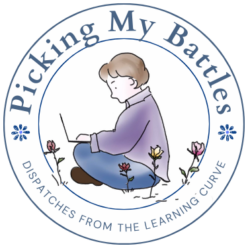I’m currently working on a book that started as a collection of short stories based on Picking My Battles. One of the things I love about the blog, however, is that each successive post not only provides an opportunity to improve skills and build friendships, it is a chance to think about the projects it’s inspiring.
The working title of my current project is called Fable. My recent decision to be candid about my own lifelong struggle with depression and mania has begun to shape it from a collection of short stories or posts into a longer piece. As I write, however, I’ve also begun to read more about other people’s experiences with these disorders.
Marbles, a graphic memoir by Ellen Forney, prompted my first first piece on the subject. The author is about my age, and many of her experiences with bipolar disorder reflected my own. Last night I continued my exploration with William Styron’s Darkness Visible. A chronicle of a major depressive episode when the author was in his 60s, it held up a different kind of mirror.
Written before the clinical language of depression had permeated our popular culture, Styron’s account of his decline and brush with suicide is unvarnished and sometimes raw. However, it is also informed by a lifetime of extensive reading and personal familiarity with other authors who suffered the same affliction and by his re-examination of his own work post-depression.
Darkness Visible isn’t the first book to look at the debated link between mental illness and creativity, and Styron didn’t restrict his anecdotes only to authors. This book about inner darkness, however, did illuminate for me how fortunate my experience has been.
My first depressive episode happened when I was two, although it was only in retrospect that my parents or I realized that was what was happening. I had another major, nearly fatal episode when I was sixteen. Now, having lived through numerous swings up and down, some with disastrous consequences, I count myself lucky even when I’m rocking at the back of my mental cave. I don’t look forward to the insomnia and anxiety and the constant contemplation of death, but, even at the very depths, there is a part of me that is always reasonably sure it will end.
This is not to say that I don’t struggle and am never tempted to fall asleep and not wake up. But, reading the account of Styron’s first major episode late in his life – the first one of which he was keenly aware – I knew I was lucky to have discovered early in life that the key to survival was the understanding that the darkness does break.
The darkness is long, and you don’t find your way out. You wait for the night to end. And, as terrifying as the beginning of Styron’s book was, with its histories of authors and housewives who had lost their battles, he closed this tiny tome by throwing out the lifeline of his own experience and survival to others who might be struggling.
My night has begun to break in the last few weeks. This one has been different, however. I still have my own lifelines. As the dawn begins to reflect off the mirrors I’ve recently acquired, however, I see a crowd through the darkness, and I’ve begun to think about how, in the light of a day not defined by fear and stigma, I can cast some of those lifelines to others.

